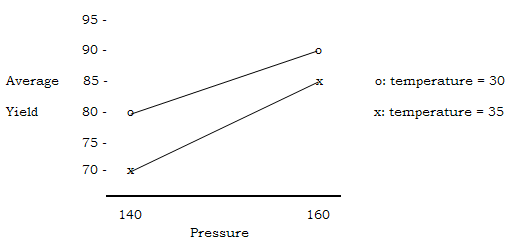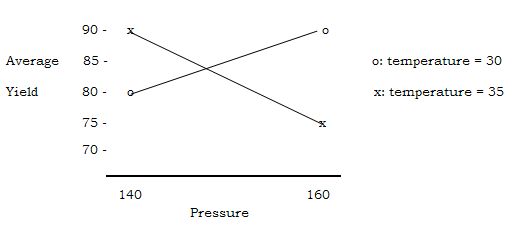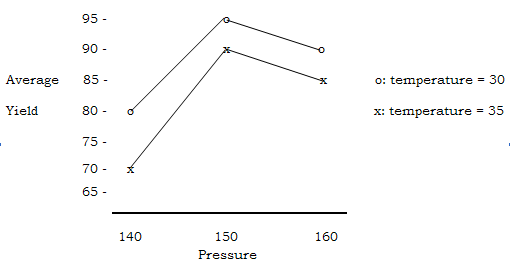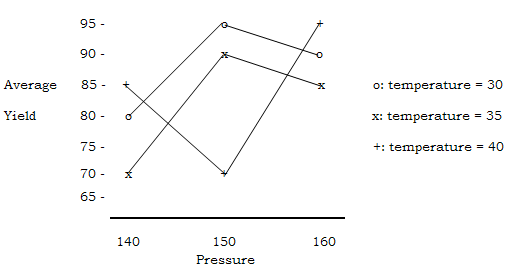|
Contents
Background
What are factorial designs?
What is a two-level factorial
design?
Detecting curvature
What is a three-level factorial
design?
What is a fractional
factorial design?
Reference
Appendix |
Background
We suggest you read our guidesheet
titled 'Design of Experiments; Improving Your Products and Processes'
(either the basic or advanced version) before reading "Understanding
Factorial Designs' in order to understand the latter better. The latter is
intended to give readers a basic understanding of what factorial designs
are all about, including the types of factorial designs that are useful to
manufacturing industries.
What are factorial Designs?
Most industrial and research
experiments involve the investigation of many variables such as
temperature, processing time, material type, humidity, etc. (henceforth
referred to as 'factors') in order determine their effects on product
quality and efficiency of manufacturing processes. For such experiments,
the DOE technique known as factorial designs (also known as factorial
experiments) are commonly used to design the experiments as well as to
draw conclusions from the experimental results. Such designs enable us
detect the effect of factors that interact, unlike the
one-variable-at-a-time method.
In factorial designs,
-
the number of levels for each of
the factors is selected by the experimenter before the experiment is
carried out.
-
the number of possible
combinations for the experiment is obtained by multiplying the levels of
all of the factors together.
-
whenever possible, the
combination are then carried out in a random order. A random number
table such as the one in the Appendix can be used for randomizing the
order of the combinations.
When all of the combinations are
carried out, the design is known as full factorial design (or simply
factorial design). When only some of the combinations are carried out, the
design is known as a fractional factorial design. The section titled 'What
is a fractional factorial design?' touches on the latter.
What is two-level factorial
design?
A two-level factorial design is a
special type of factorial design. For such a design,
-
the number of levels selected
for each of the factors in the experiment is two.
-
the number of possible
combinations for the experiment is 2k, where k is the number of factors.
-
the combinations are carried out
in a random order.
Since each of the factors is at
two-levels, the number of combinations can be kept to a reasonable number
as k increases. This can be seen in Table 1.
Table 1
|
k |
No. of combinations |
|
2
3
4
5 |
22 = 4
23 = 8
24 = 16
25 = 32 |
A two-level factorial design is
therefore useful when there are many factors to investigate in the
experiment such as during process characterization, in which the objective
is to determine the critical process factors. An actual example is given
in the Appendix. However, if the process is already close to optimum
conditions, the use of a factorial design that enables the critical
factors to be studied over many levels may be more appropriate such as the
use of a three-level factorial design. The latter is covered in the
section titled 'Three-level factorial designs'.
Example
The simplest example of a
two-level factorial design is when there are only two factors is the
experiment.
-
Let us label the factors as A and
B; and the factor levels as A1, A2, B1, and B2.
-
The number of possible
combinations is 22 = 4. Table 2 lists the four combinations which are
labeled as 'factor combinations'. The four facto combinations in Table 2
are said to be in 'standard order', that is the levels of A are alternated
with each other in column 2 while the levels of B are alternated in pairs
in column 3.
Table 2
|
Factor
Combination |
Factor A |
Factor B |
|
1
2
3
4 |
A1
A2
A1
A2 |
B1
B1
B2
B2 |
-
For each factor combination, an
important measure of product quality or process efficiency or both such as
yield, tensile strength, percent shrinkage, assembly time, cycle time,
cost, etc. is obtained (henceforth referred to as 'response'). More than
one product quality or process efficiency measures can be obtained.
-
The experiment is repeated more
than once in order to increase our confidence in the results of the
experiment i.e. each of the factor combinations is performed more than
once. Suppose the experiment is repeated twice. Since each of the factor
combinations is performed twice, we will then have a total of eight runs
for the experiment as shown in Table 3; the number of runs for each of the
factor combinations being two.
Table 3
|
Factor
Combination |
Run |
Factor A |
Factor B |
Response |
|
1
1
2
2
3
3
4
4 |
1
2
3
4
5
6
7
8 |
A1
A1
A2
A2
A1
A
A2
A2 |
B1
B1
B1
B1
B2
B2
B2
B2 |
R1
R2
R3
R4
R5
R6
R7
R8 |
-
To avoid any unknown systematic
factors from affecting the results of the experiment, the order of
performing the runs should be randomized. This is illustrated in the
Appendix.
-
The results of the runs are
recorded as R1, R2, ...., R7 and R8 as can be seen in Table 3. The average
of the results for the two runs at each of four factor combinations is
then calculated and analyzed using either graphical or more formal
statistical methods. The variability of the results for the runs at the
four factor combinations can also be analyzed if one wishes to do so. The
absolute value of the difference between : R1 and R2; R3 and R4; R5 and
R6; and R7 and R8 can be used as a measure of the variability of the
results (i.e. range value).
A practical example
Let us suppose that for Table 2,
-
A and B represent pressure (in mm
per second) and temperature (in degrees Celsius) respectively
-
A1 = 140, A2 = 160, B1 = 30, B2 =
35
-
response represents yield (in
percent)
Suppose the yields are as shown in
Table 4.
Table 4
|
Run |
Pressure |
Temperature |
Yield |
Average Yield |
|
1
2
3
4
5
6
7
8 |
140
140
160
160
140
140
160
160 |
30
30
30
30
35
35
35
35 |
78
82
92
88
68
72
83
87 |
80
90
70
85 |
We will plot the average yields n
Table 4 as shown in Figure 1.

Figure 1: Slight interaction
between temperature and pressure
-
increasing pressure corresponds to
an increase in average yield for both temperature levels. Therefore, the
higher pressure level should be used to increase the average yield
regardless of the temperature level. However, the increase in average
yield is greater for the case of the higher temperature level (15%) as
compared to the case of the lower temperature level (10%). This suggests
that there is slight interaction between temperature and pressure, but it
doesn't affect the earlier advice to use the higher pressure level.
-
best condition is when pressure is
at the higher level and temperature is at the lower level for which the
average yield is 90 percent. If such a yield is deemed adequate, the
combination of higher pressure and lower temperature levels of 160 mm per
second and 30 degrees Celsius respectively should be carried out several
times in order to verify its yield before using this particular
combination on the manufacturing floor. It is likely that average yields
of more than 90 percent can be achieved with pressure levels that are
higher than 160 mm per second and temperature levels that are lower than
30 degrees Celsius. Further experimentation is need to verify this.
Another scenario
Suppose the yields had turned out
as in Table 5.
Table 5
|
Run |
Pressure |
Temperature |
Yield |
Average Yield |
|
1
2
3
4
5
6
7
8 |
140
140
160
160
140
140
160
160 |
30
30
30
30
35
35
35
35 |
78
82
92
88
88
92
73
77 |
80
90
90
75 |
The plot of the average yields in
Table 5 is shown in Figure 2.

Figure 2: Marked interaction
between temperature and pressure
From the plot, it appears that
-
pressure and temperature interact,
as revealed by the crossing lines. At the lower temperature level,
increasing pressure corresponds to an increase in average yield. The
higher pressure level should be used to maximize the yield at this
temperature level.
-
best condition is when pressure is
at the tower level and temperature is at the higher level or when pressure
is at the higher level and temperature is at the lower level, for which
the average yield is 90 percent. We need to choose one of these two
combinations, and to run it several times in order to verify its yield
before using the combination on the manufacturing floor. The figure
suggests that mid-pressure should also be investigated.
Detecting Curvature
When using two levels, it is
assumed that the effect of the factors is approximately linear over the
range they are tested at. That is, we assume there isn't any intermediate
alue between the two levels that corresponds to the best condition. It
this is a possibility, three levels should be investigated as illustrated
below.
Example
Suppose three levels are to be
used for pressure; 140, 150 and 160, since we suspect that the pressure
value of 150 corresponds to the best condition. The number of levels for
temperature is still two; 30 and 35. The number of possible combinations
is now 3 x 2 = 6. Suppose the experiment is carried out twice, and that
the order of the 6 x 2 = 12 runs are randomized. Suppose that the average
of the yields from the two runs at each of the 6 factor combinations is as
shown in Table 6.
Table 6
|
Factor
Combination |
Pressure |
Temperature |
Average yield |
|
1
2
3
4
5
6 |
140
150
160
140
150
160 |
30
30
30
35
35
35 |
80
95
90
70
90
85 |
The plot of the average yields in
Table 6 is as shown in Figure 3.

Figure 3: Curved relationship
between pressure and yield
From the plot, it appears that
-
for both temperature levels, here
is a curved relationship between pressure and average yield, and that the
best average yield corresponds to the intermediate pressure level.
-
the lower temperature level seems
to give better average yield than the higher temperature level. However,
the difference in average yield between the two temperature levels at the
intermediate and higher pressure levels are slightly smaller than that at
the lower pressure level (i.e. 5% compared to 10%). This suggests that
there is slight interaction between temperature and pressure but it
doesn't affect our earlier advice to use the intermediate pressure level.
-
the best condition is when
pressure is at the intermediate level and temperature is at the lower
level for which the average yield is 95 percent. Before using this
combination of pressure and temperature on the manufacturing floor, it
should be carried out several times in order to verify its yield.
What is a three-level factorial design?
For a three-level factorial
design,
-
the number of levels selected for
each of the factors in the experiment is three.
-
the number of possible
combinations for the experiment is 3k, where k is the number of factors.
-
the combinations are carried out
in a random order.
Example
Suppose both pressure and
temperature are to be tested at three levels; the levels being 140, 150,
and 160 for pressure and 30, 35, and 40 for temperature. The number of
possible combinations is now 32 = 9. Suppose the experiment is
carried out twice, and that the order of the 9 x 2 = 18 runs are
randomized. Suppose the average of the yields from the two runs at each of
the nine factor combinations is as shown Table 7. As mentioned before, the
advantage of using three levels is our ability to detect a curved
relationship.
Table 7
|
Factor
Combination |
Pressure |
Temperature |
Average Yield |
|
1
2
3
4
5
6
7
8
9 |
140
150
160
140
150
160
140
150
160 |
30
30
30
35
35
35
40
40
40 |
80
95
90
85
70
95
70
90
85 |
The average yields in Table
are plotted as shown in Figure 4.

Figure 4: Temperature-pressure
plot
From the above plot,
-
the curves cross indicating
a crucial interaction between temperature and pressure. This is why best
average yield corresponds to the intermediate pressure level for both the
low and high temperature levels but not for the low temperature level. For
the latter, the intermediate pressure level produces the worst average
yield.
-
the best condition is when
pressure is at the intermediate level and temperature is at the
intermediate level. We need to choose which of these two to use, e.g. the
cheaper combination, and to run it several times in order to verify its
yield.
What is a fractional factorial design?
When the number of factors in the
experiment (k) is large,
Table 8
|
k |
No. of combinations |
|
5
6
7
8 |
25 = 32
26 = 64
27 = 128
28 = 256 |
Fortunately, designs known as
two-level fractional factorial designs can be used to obtain the
information that we need without having to carry out all of the
combinations. For instance, for an experiment involving 5 factors, each at
two levels, only 16 out of the 32 possible combinations is needed in order
to determine which are the critical factors as well as which pairs of
factors interact. Montgomery (2000) including other DOE textbooks contains
details of such designs including the method for selecting the
combinations.
An actual example of a two-level
fractional factorial design is given in the Appendix.
Table of Random Numbers

References
Montgomery, D.C. (1997) Design and
Analysis of Experiments, Fourth edition, John Wiley & Sons Inc.,
Singapore.
Oh, S. H. (1995) Quality Control
and Machine Vision System, Final Year Project Report, School of Industrial
Technology, Universiti Sains Malaysia.
<< Appendix >>
|




